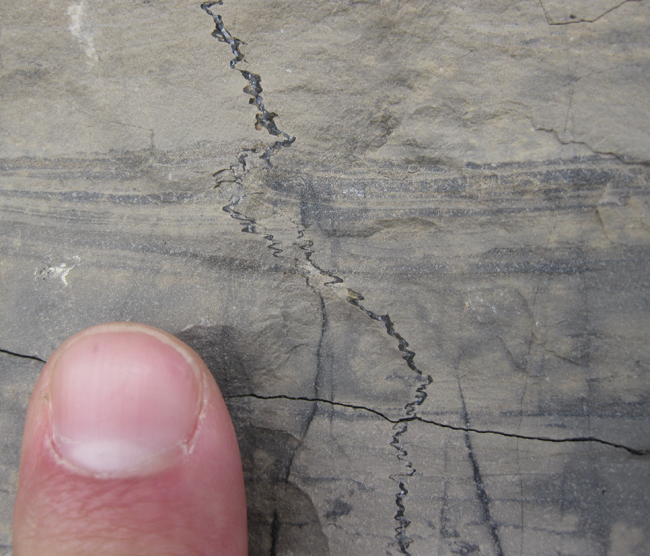Often, stylolites (pressure solution seams) are bedding parallel in susceptible sedimentary rocks. They are shaped like “beds of nails,” overall planar, but with pointy bits that poke up and down, perpendicular to that plane.
The stylolites form with an orientation that is overall perpendicular to the maximum principal stress direction, and the little “teeth” parallel to the maximum principal stress direction.
Often stylolites form in sedimentary rocks parallel to bedding (that is, horizontally) because the maximum stress is vertical (due to loading of overlying sedimentary layers).
But sometimes we find stylolites that cut across bedding at some angle, and these are inferred to have formed due to more horizontal (i.e., tectonic) stresses.
Here is an example (cross-sectional view, perspective parallel to the bedding plane) I found last month on Corridor H, West Virginia:

This is a chunk of Silurian-aged Tonoloway limestone. Closer in, you can see some additional detail of this structure:

Here’s a view of the bedding plane (“map view”), showing the trace of the stylolite cutting across bedding:

From a study of in situ examples of stylolites like these, one can infer the maximum principal stress direction (σ1) and thus potentially the direction of tectonic transport. They are subtle things, but in aggregate, a bunch of little stylolites can tell you about regional-scale tectonics.
These rocks were deposited during the Silurian, but obviously the stylolites would have formed well after that, sometime after the carbonate mud was lithified to limestone. Probably they are Alleghanian in age – due to the collision of ancestral Africa with ancestral North America during the late Paleozoic periods called the Pennsylvanian and Permian.

Think there is a typo in paragraph 2 … parallel to the ‘minimum’ principal stress direction
This seems right to me, Astrid. Which part of the sentence are you proposing to replace with “mimimum”?
The little teeth on a stylolite do not point in the minimum principal stress direction. They point in the direction of the maximum principal stress.
Clearly I need more coffee! My mistake … I read it wrong.
Do you think you can get any indication of Sigma 2 or Sigma 3 from the Stylolite? Trying to see if we can garner more information from them in core…
More coffee is always a good solution!
It’s a good question about sigma-2 and 3. I wonder if the morphology of the “teeth” could reveal this – whether they are more conical (like alligator teeth) or “wedge” shaped (like shark teeth)… But I don’t know.
“principle” should be “principal” everywhere in this article
You’re absolutely right. I’ve fixed it.